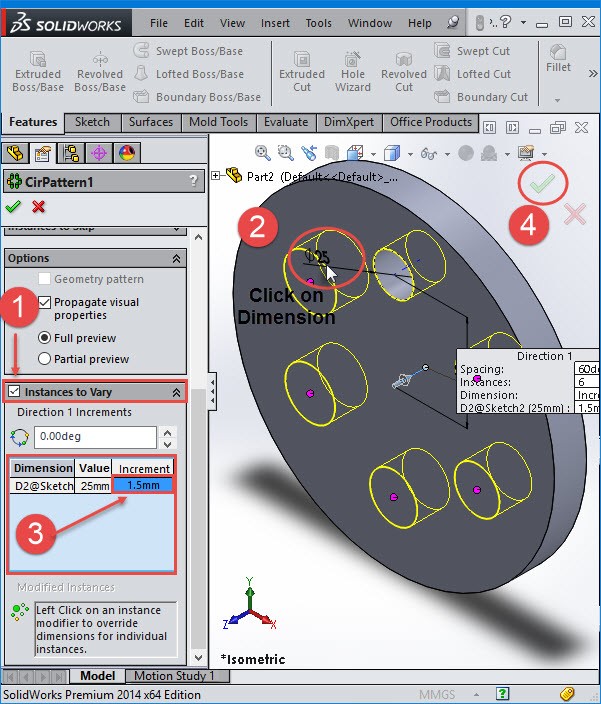

How to Create a Bill of Materials in SolidWorks. We specialize in ¼-Turn Panel and Cowling fasteners, specifically in 303 stainless and our unique lightweight, high strength Skytanium ® materials. The Toolbox is an add-in - not loaded by default. Sc in Mechanical Engineering from the University of Calgary and is an Elite SOLIDWORKS AE with over 25 certifications from Dassault Systemes. On the contrary, the inserted fasteners do not contain custom properties that you want. TOPICS Introduction Thread terminology Thread drawing and dimensioning Threaded fastener 3. Add custom fastener files, set the Property State to No and click Apply. Steel 17-4PH fasteners provide numerous beneficial properties that make it a go-to material for a wide range of industrial applications. Nestled in all of our parts are engineering properties, as well as a description for BOM, hole size, torque, etc.

Instead we will insert the holes If you don’t have access to SolidWorks Toolbox Smart Fasteners then there is an alternative method to quickly add fasteners to your assembly. The second: Positions, will give you a graphical 123GO is the fastest and easiest way to insert fasteners and their related holes and mates automatically. Progressive's Inserted Bar Locks are engineered for long-term alignment of very large molds. How to make a thread in SOLIDWORKS – Basic. Today Spaenaur serves thousands of customers working in diverse industries. Right-click on the part and apply the SBOM developed in SolidWorks comes in handy when dealing with spare parts orders or helping the customers identify the faulty part. It’s a fundamental part of three-dimensional design, finding problems in your designs but when you work with a lot of fasteners you can run into a few speed bumps. Smart Fastener is very useful in creating Detailed Design. Smart Fasteners combines hole wizard features with the SOLIDWORKS Toolbox library of fasteners. The exact position of the boss can also In this video you will discover everything you need to know about the interference detection tool in SolidWorks. To find more tutorial videos like the one shown above, visit you don’t have access to SolidWorks Toolbox Smart Fasteners then there is an alternative method to quickly add fasteners to your assembly. The assembly will then behave as a linked chain. Select the number of links or components desired in the “Chain Path” box and accept your changes. To do this, start by selecting a chain path and then select the individual linked components, path links and path alignments. The third chain pattern option, “Connected Linkage,” lets a user create a pattern of linked components, like a bike chain. As seen in the video walkthrough, the chain pattern behaves just as desired. Selecting the two wheels of a base for their definitions, then selecting the components right plane for the path alignment, users should space the components equally before accepting changes. This allows a user to define two path link references to produce the desired behavior. What if a user needed the base to stay perpendicular to the chain path as it follows it? For this, it is recommended to use the “Distance Linkage” option. After clicking OK, the rollers can be dragged along the outlined path. When doing this, select the cylindrical face to define the path link reference and choose an existing component reference plane for the path alignment. If a user wanted to pattern a chain of components that were symmetrical about their link-pivot point, like a simple roller for example, using the Distance option would be recommended. This can be done in the “Chain Group 1” box. Selecting the mount base in the graphics area will pattern the component. The number of links or instances can be entered below the Selection Manager. Selecting “Path,” the Selection Manager can be used to select only the closed loop portion of a sketch.

Underneath these options, a “Chain Path” box should be visible.

Three types of pattern options can be used: “Distance”, “Distance Linkage” and “Connected Linkage.” Within the dropdown menu, select “Chain Component Pattern.” To activate the chain component command, users can find a “Linear Component” dropdown menu under the “Assembly” command manager. In the first example shown, a mounting base must be patterned at regular intervals around an outlined path. In the video walkthrough above, we look at how to pattern components along an open or closed loop path with three different pattern options. With SOLIDWORKS, roller chains, energy chains and power transmission components can be simulated within an assembly document.


 0 kommentar(er)
0 kommentar(er)
